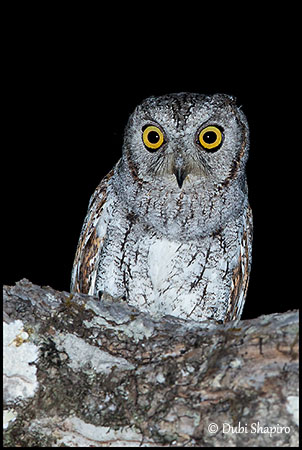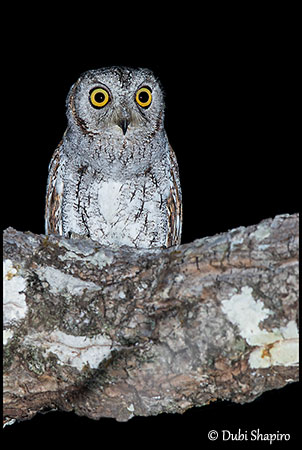
At the beginning of the breeding season, the males usually sing close to potential nesting sites including holes in trees or walls, or nest-boxes when available.
It enters the cavity and sings from the entrance to attract a female. Both mates often duet during the courtship displays. During this period, the male may produce its mating call during the day, up to 30 times per minute. The female utters a squeal in response.
The southern populations are resident but the northern birds are migratory. The birds from E Siberia and Japan spend the winter in India (and probably on Andaman and Nicobar Islands), also in China and S to Malaysia and Sumatra.
This species is vagrant to North America and has been recorded twice in Alaska in spring.
The flight of the Oriental Scops-Owl is typically silent due to the soft flight-feathers. In addition, the owl is virtually silent and stops screaming before the start of the flight.
REPRODUCTION OF THIS SPECIES:
The laying occurs between February-April and May in India and Pakistan, mostly April/June in Siberia and China, and May/June in Japan.
The nest-site is selected by the male. The Oriental Scops-Owl nests in hollows in trees or walls, but nest-boxes are used when available. It also uses holes or other cavities in buildings. The nest is placed at variable heights above the ground.
The female lays 3-4 white eggs directly on the floor of the cavity. She incubates alone during 24-25 days, but she is fed by the male during this period.
At hatching, the downy chicks are whitish. They are fed by both parents, but the male does most of hunting duties in order to feed the family. The young usually depend on parents for food during 3-4 weeks after leaving the nest.
PROTECTION / THREATS / STATUS:
The Oriental Scops-Owl is described as rather common in most parts of the range, but it is scarce in some areas such as Pakistan and Sri Lanka.
The species is threatened by conversion of its habitat for agriculture, by hunting and trade in some countries, and by environmental pollutants.
The size of the population is unknown, but it is suspected to be stable.
The Oriental Scops-Owl is not globally threatened and currently evaluated as Least Concern.
Fr: Petit-duc d’Orient
Ang: Oriental Scops-Owl
All: Orient-Zwergohreule
Esp: Autillo Oriental
Ita: Assiolo orientale
Nd: Oosterse Dwergooruil
Sd: orientdvärguv
Photographer:
Dubi Shapiro
Dubi Shapiro Photo Galleries
Text by Nicole Bouglouan
Sources:
HANDBOOK OF THE BIRDS OF THE WORLD Vol 5 by Josep del Hoyo-Andrew Elliott-Jordi Sargatal - Lynx Edicions - ISBN: 8487334253
OWLS OF THE WORLD – By Claus König, Friedhelm Weick and Jan-Hendrik Becking - IBSN 978-0-7136-6548-2
A photographic guide to Birds of Vietnam, Cambodia and Laos by Peter Davidson. New Holland Publishers. ISBN: 9781847731418
A Field Guide to the Birds of China De John Ramsay MacKinnon, John MacKinnon, Karen Phillipps, Fen-qi He - OUP Oxford, 2000 – ISBN: 0198549407, 9780198549406 – 586 pages
Owling.com - The largest US website totally dedicated to owls
Oriental Scops-Owl
Otus sunia
Strigiformes Order – Strigidae Family
INTRODUCTION:
The Oriental Scops-Owl shares its large range with several subspecies. It frequents various types of forests, orchards and gardens, and can be found around city lights and temples, depending on the range. It feeds mainly on insects and spiders, but small rodents and birds are also part of its diet. It typically nests in hole in tree or wall, in buildings or in nest boxes when available.
This species occurs in two morphs, rufous and grey-brown. It is nocturnal and hunts at night, whereas during the day, it roosts in trees or bushes.
The Oriental Scops-Owl is described as scarce, local, fairly common or uncommon, according to the range. But the species is not globally threatened for the moment.
DESCRIPTION OF THE BIRD:
Biometrics:
Length: 17-21 cm
Wingspan: 43-53 cm
Weight: 75-95 g
The Oriental Scops-Owl occurs in two morphs.
In the rufous morph, the upperparts are rufous with dark streaks on crown and forehead. The scapulars show buffy-white spots with blackish edges. Wings and tail show pale and dark barring.
The underparts are slightly paler, becoming buffy-white on belly. Neck and breast have dark shaft streaks and fine horizontal vermiculations.
On the head, the facial disk is pale rufous with whitish area around the bill and white eyebrows. There is an indistinct nuchal collar, spotted rufous, black and white. The facial disk is narrowly lined with dark. The ear-tufts are short, about 15-25 mm. They usually lay flat against the head.

O. s. distans
Grey-brown morph
The grey-brown morph resembles Eurasian Scops Owl but with less patterned upperparts, whereas underparts show strong black streaking with some variations. The ground-colour is greyish-brown or reddish-grey.
The bill is blackish, and often completely hidden by the rictal bristles growing at bill base. The eyes are yellow. The tarsi are feathered to the base of the greyish-brown toes. The claws are blackish-brown.
The female is similar but she is slightly larger than male.
The juvenile resembles adult with faint barring on back and underparts.
SUBSPECIES AND RANGE:
The Oriental Scops-Owl has nine subspecies.
There are some small differences between the races. Both O.s. stictonotus and O.s. japonicus are larger and paler than nominate race, whereas O.s. malayanus and O.s. rufipennis are dark. The race O.s. leggei is darkest and smallest, and a cinnamon-bay morph exists.
O. s. japonicus is found in Japan S to C Kyushu.
O. s. stictonotus occurs in SE Siberia, Sakhalin, NE China, and N Korea. It winters in S China S to N Malay Peninsula.
O. s. malayanus is found in S China (Yunnan E to Guangdong). It winters from S Myanmar and extreme S Thailand S to Sumatra, Bangka and Belitung.
O. s. sunia (Oriental Scops-owl) occurs in N Pakistan E through Himalayas to Bangladesh and NE India, and S in India to Odisha.
O. s. rufipennis occurs in S India.
O. s. leggei is found in Sri Lanka.
O. s. distans occurs in Myanmar, N and W Thailand and Indochina.
O. s. nicobaricus is found in C Nicobars.
O. s. modestus (Walden's Scops Owl) occurs in the Andamans.
HABITAT:
The Oriental Scops-Owl usually hunts near forest edges and in open areas. It can be seen near the street lights in urban areas, especially in Sri Lanka.
It generally frequents deciduous and mixed forests, but also the open evergreen forest, semi-open woodland, parks, savannas with scattered trees and orchards.
It can be seen in groves near settlements and cultivated areas in Indian Subcontinent. In Japan, it is often seen around temples and in taller trees.
This species occurs mainly in lowlands and foothills to 1,500 metres, and up to 2,300 metres of elevation in the Himalayas.
CALLS AND SONGS: SOUNDS BY XENO-CANTO
The Oriental Scops-Owl may use several vocal signals. The song is a sequence of trisyllabic phrases consisting of resonant, throaty notes audible over a distance of several hundred metres “kroik ku kjooh, kroik ku kjooh…”
The song of birds of S China has slightly different rhythm, with second and third notes more drawn together. It is described as “kroik-kukjoohk”. Other subspecies give slightly different songs, probably due to individual or geographic variation.
When they are quiet, the young owls utter a soft whistle “ooook-oooe” but anxious sounds are described a “u-rr-rr-r” whereas a sharp “aaou” is given when the birds are frightened.
BEHAVIOUR IN THE WILD:
The Oriental Scops-Owl is nocturnal and usually starts to hunt at dusk. It feeds primarily on insects and spiders, but small vertebrates such as rodents and birds are also part of its diet.
It hunts from perch on in flight. As soon as the prey is located, the owl swoops down on to it and catches it on the ground. Insects and spiders can be taken from the vegetation, often in tree canopy.
The Oriental Scops-Owl roosts singly during the day, and occasionally in small groups. The owls are hidden among the dense foliage, sleeping in tree holes or against the trunk where their cryptic plumage makes them almost invisible.
After sunset, the male begins to sing. If the bird is detected, it adopts a vertical posture with sleeked plumage while the short ear-tufts are erected and the eyes half-open.

O. s. distans
Grey-brown morph